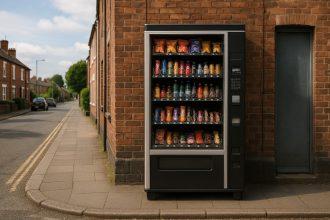|
Getting your Trinity Audio player ready...
|
Are you unsure how to renew your provisional driving licence in the UK? You’re not alone. Thousands of learner drivers across the country find themselves confused when it’s time to renew, especially with the different processes, fees, and eligibility criteria involved.
Whether your licence is about to expire, your personal details have changed, or you’re simply planning ahead, renewing a provisional licence is a straightforward task if you know where to start.
In this guide, you’ll find everything you need to know about the renewal process, from online applications to visiting the Post Office or sending off paperwork by post.
We’ll also cover important documents you’ll need, costs involved, how long it takes, and common mistakes to avoid. By the end, you’ll feel confident in your ability to renew your provisional driving licence quickly and correctly. Let’s break it down step by step.
What Is A Provisional Driving Licence?
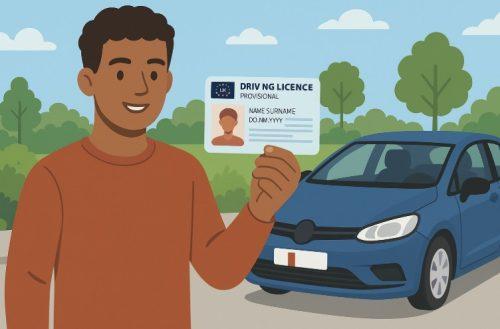
In the UK, a provisional driving licence serves as the legal starting point for learning to drive. It authorises you to drive on public roads under supervision and to take your driving tests. However, many people are unaware that this licence isn’t valid indefinitely.
A provisional licence typically needs to be renewed every 10 years. Renewal ensures that the information on your licence, such as your photograph and personal details, remains accurate and up to date. For drivers over the age of 70, renewal is required every three years.
There are several reasons why your provisional licence might need to be renewed:
- It has reached its expiry date
- Your appearance has changed significantly
- Your name or title has changed due to marriage or other reasons
- You have developed a medical condition that must be declared
Keeping your licence renewed is crucial for staying legally eligible to drive and to continue learning without interruption.
When Should You Renew Your Provisional Licence In The UK?
Knowing when to renew your provisional licence is just as important as understanding how to do it. The DVLA prints the expiry date clearly on the front of your licence, at position 4b. If you overlook this date, you risk driving with an expired licence, which is a legal offence.
Typically, a provisional licence remains valid for 10 years from the date it was issued. However, drivers aged 70 or older must renew their licence every three years. Additionally, you should renew early if there are any changes in your medical or personal details that may affect your licence.
You will often receive a reminder letter from the DVLA when it’s time to renew. While this letter is helpful, it’s ultimately your responsibility to check and act before the expiry date. Renewing at the right time ensures that you remain on the road legally and without any administrative setbacks.
What Are The Ways To Renew Your Provisional Licence?
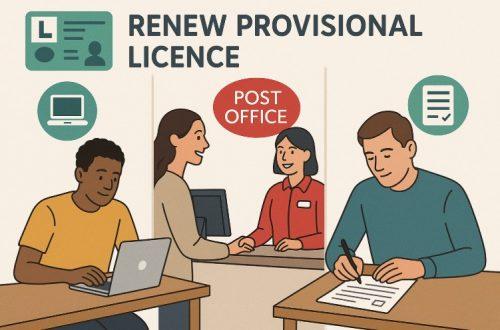
There isn’t a one-size-fits-all method for renewing your provisional licence in the UK. Fortunately, the DVLA offers multiple options to suit different situations and preferences.
The three available methods are:
- Online through the DVLA’s official website
- In person at selected Post Office branches
- By post using a D1 application form
Each method has its own set of benefits. The online method is the most convenient and cost-effective for most people. It allows you to complete the process quickly, and you’ll typically receive your new licence within a week.
The Post Office option is useful if you prefer personal assistance. It’s slightly more expensive but includes a photo service and hands-on support.
The postal method is required if your name or title has changed, or if you are unable to access digital services. Choosing the appropriate method ensures a smoother and quicker renewal experience.
How Do You Renew Your Provisional Licence Online?
Renewing your provisional driving licence online is often the fastest and most straightforward method. It’s designed to be user-friendly and is available to most residents in Great Britain.
To get started, you’ll need to visit the official GOV.UK website and access the DVLA renewal service. If you haven’t used the service before, you’ll be prompted to create a user account. Once signed in, follow the guided steps to submit your application.
Here’s what you’ll need:
- Your current provisional licence
- A valid UK passport for photo and ID verification
- Your National Insurance number
- A list of addresses you’ve lived at over the last three years
- A debit or credit card to pay the £14 renewal fee
After submitting the form, you will receive a confirmation email. Your new licence should arrive within a week. If your identity cannot be verified digitally, you may be asked to submit additional documents by post. Online renewal is the recommended option for most learners due to its speed, affordability, and ease of use.
Can You Renew Your Provisional Licence At The Post Office?

Yes, the Post Office offers a convenient in-person method for renewing your provisional licence. This is particularly useful if you prefer speaking with someone face-to-face or do not have easy internet access.
To use this service, visit a participating Post Office with your DVLA reminder letter, if you received one. If you didn’t receive a letter, bring your current photocard licence. The Post Office staff will take a new passport-style photo and help you complete the renewal process digitally.
Here’s what you’ll need:
- Your current photocard licence
- Your DVLA renewal reminder letter (if applicable)
- £21.50 to cover the renewal and photo service
Please note that if your name or title has changed, you cannot use this method and must apply by post. Additionally, the processing time is longer than the online option, taking up to three weeks. The Post Office option provides peace of mind for those who want guided help with the renewal process.
How Do You Apply For Provisional Licence Renewal By Post?
For those who can’t use online or Post Office renewal services, or who have specific circumstances like a name change, postal renewal is a reliable alternative.
To begin the process, visit a Post Office that provides DVLA services and request a D1 application pack. This pack includes the form and an instruction leaflet (INF1D) to help you fill it out correctly.
Your postal application must include:
- A completed D1 form
- A recent passport-style photo (not signed)
- Your current provisional licence
- A cheque or postal order for £17, payable to DVLA
- Supporting documents if you’ve changed your name
Mail everything to:
DVLA
Swansea
SA99 1DH
Make sure to double-check the information before sending. If there are any errors or missing documents, your application could be delayed. Postal renewals generally take up to three weeks, and sometimes longer if additional checks are needed.
How Much Does Provisional Licence Renewal Cost?
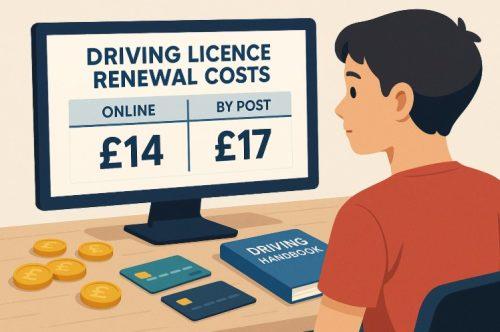
Understanding the cost involved in renewing your provisional licence helps you choose the best method for your situation. The fees vary depending on the route you take.
| Renewal Method | Fee | Processing Time |
| Online (DVLA website) | £14 | Around 1 week |
| Post Office | £21.50 | Up to 3 weeks |
| By Post (D1 Form) | £17 | Up to 3 weeks |
| Drivers Over 70 | Free | Varies |
| Medical Short Period | Free | Varies |
The online method is the cheapest and fastest. Post Office renewals include the cost of photo processing, which is why they are slightly more expensive.
Before applying, ensure you have the correct payment method. For online renewals, you’ll need a debit or credit card. Postal renewals require a cheque or postal order. Choosing the right method not only saves you money but can also reduce waiting times.
What Happens After You Submit Your Renewal Application?
Once your application is submitted, the DVLA will begin processing it. If you applied online, you should receive a confirmation email shortly after submission. For Post Office or postal renewals, confirmation is not always immediate, but processing will still begin once your documents are received.
After your application is approved, your new provisional licence will be issued and sent to your home address. Online renewals generally arrive within a week, while Post Office and postal applications may take up to three weeks.
You are required to send your old licence photocard back to the DVLA once your new one arrives. The return address is provided during the application process or in your confirmation letter.
Understanding this process ensures you’re prepared to complete the renewal efficiently and continue learning to drive without interruption.
What If You Can’t Use Online Or In-Person Services?

Not every applicant can use online or in-person services, particularly if your circumstances are more complex. For example, if your name has changed or you lack a digital passport for ID verification, online renewal won’t be an option.
In such cases, the DVLA recommends applying by post. This method allows you to include paper documents that confirm your identity or any changes to your personal details.
You may also contact DVLA directly for support, particularly if you:
- Need to use the Welsh language version of the service
- Have accessibility or medical concerns
- Require large print or audio forms
These additional services make the renewal process more inclusive and accessible to all drivers, regardless of their specific needs.
What Documents Do You Need For Provisional Licence Renewal?
Having the correct documents prepared in advance will ensure that your renewal is processed without delays. While the exact requirements vary depending on your chosen renewal method, several core documents apply across all types.
You may need:
- Your current photocard provisional licence
- A valid UK passport (for online identity confirmation)
- Your National Insurance number
- Your full address history for the past three years
- A recent passport-style photograph (for postal or Post Office applications)
- Proof of name change, such as a marriage certificate or deed poll
Missing or incorrect documentation is one of the most common causes of application delays or rejections. It’s important to check the list carefully before submitting your renewal.
Proper preparation ensures that your application can be processed smoothly and that you’ll receive your new licence in the expected timeframe.
What Are Common Mistakes To Avoid When Renewing?
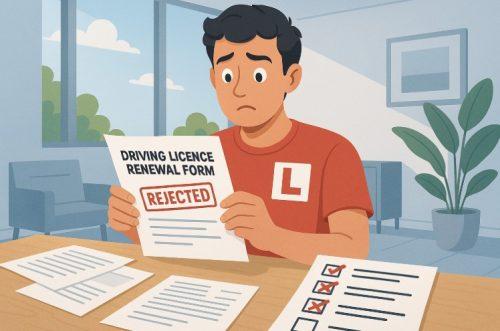
Many learner drivers face delays or complications during the renewal process due to small, avoidable errors. Being aware of these mistakes can help you avoid setbacks.
Here are some common pitfalls:
- Failing to check the expiry date on your licence
- Submitting an incomplete application
- Using outdated or incorrect documents
- Forgetting to include a passport-style photograph for postal applications
- Applying online after changing your name or title (which requires a postal application)
Double-check all sections of your application and ensure your payment method is valid before submission. If anything is unclear, consult the DVLA guide or contact their helpline for clarification. By avoiding these common mistakes, you’ll significantly increase your chances of a quick and successful provisional licence renewal.
Can You Still Drive While Waiting For Your Renewed Licence?
Many learners worry about whether they can continue driving while their renewal is being processed. The good news is that, in most cases, the DVLA permits you to keep driving as long as certain conditions are met.
You may continue driving if:
- Your current licence has not been revoked or refused
- You submitted your renewal before your licence expired
- You meet the medical and legal requirements for driving
- You only drive under the conditions allowed by your provisional licence (e.g., with supervision and L plates)
However, if your renewal is delayed due to missing documents or medical review, you may be advised to pause driving until approval is confirmed. Understanding these rules helps ensure you stay compliant while waiting for your new licence to arrive.
Conclusion
Renewing your provisional driving licence in the UK doesn’t have to be complicated. Whether you choose to apply online, visit a Post Office, or submit your application by post, the process is straightforward when you’re well-informed and prepared. Knowing when to renew, what documents to have ready, and how much to pay can make a big difference in how smoothly your application is processed.
Staying on top of your licence renewal ensures that your driving journey continues without delay or legal trouble. If you’ve already started learning or plan to take your driving test soon, keeping your provisional licence current is essential.
With the options and guidance now clearly laid out, you can choose the method that suits your needs and stay focused on reaching your goal of becoming a fully licensed driver. Don’t wait for the last minute, take action now and drive forward with confidence.
FAQs
How Long Is A Provisional Licence Valid In The UK?
Provisional licences are valid for 10 years, after which they must be renewed.
Can I Drive With An Expired Provisional Licence?
No. Driving with an expired licence is illegal and could invalidate your insurance.
Do I Need A New Photo To Renew My Licence?
Yes, unless renewing online with a valid UK passport, where your existing photo can be used.
What Happens If My Name Has Changed?
You’ll need to apply by post and include proof of the name change, such as a marriage certificate.
How Do I Know When My Licence Expires?
Check the front of your licence at position 4b. The DVLA also sends reminders.
Can I Renew My Licence Early?
Yes, especially if your medical details or personal information have changed.
What If I’ve Lost My Licence?
You must apply for a replacement licence through the DVLA website before renewing.








